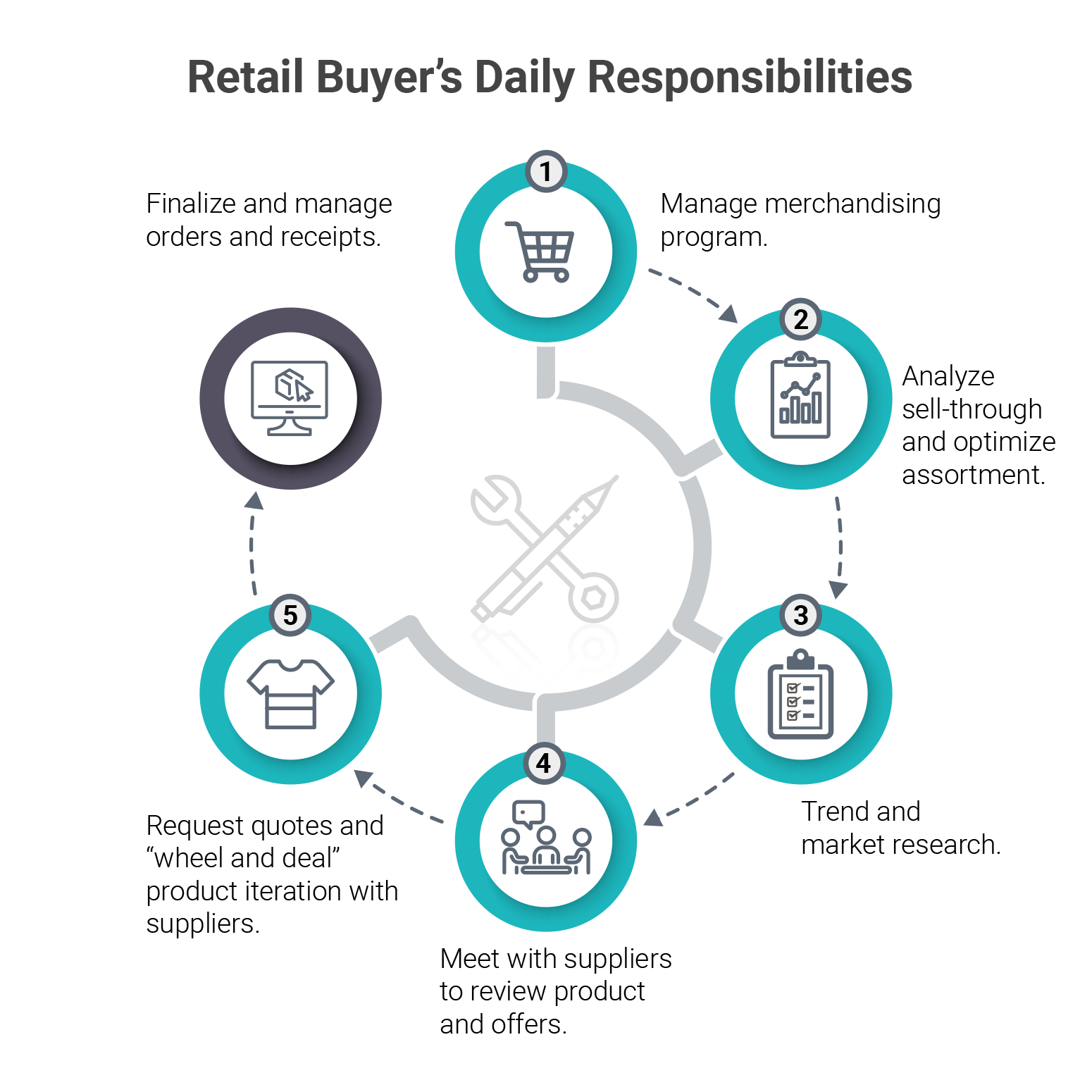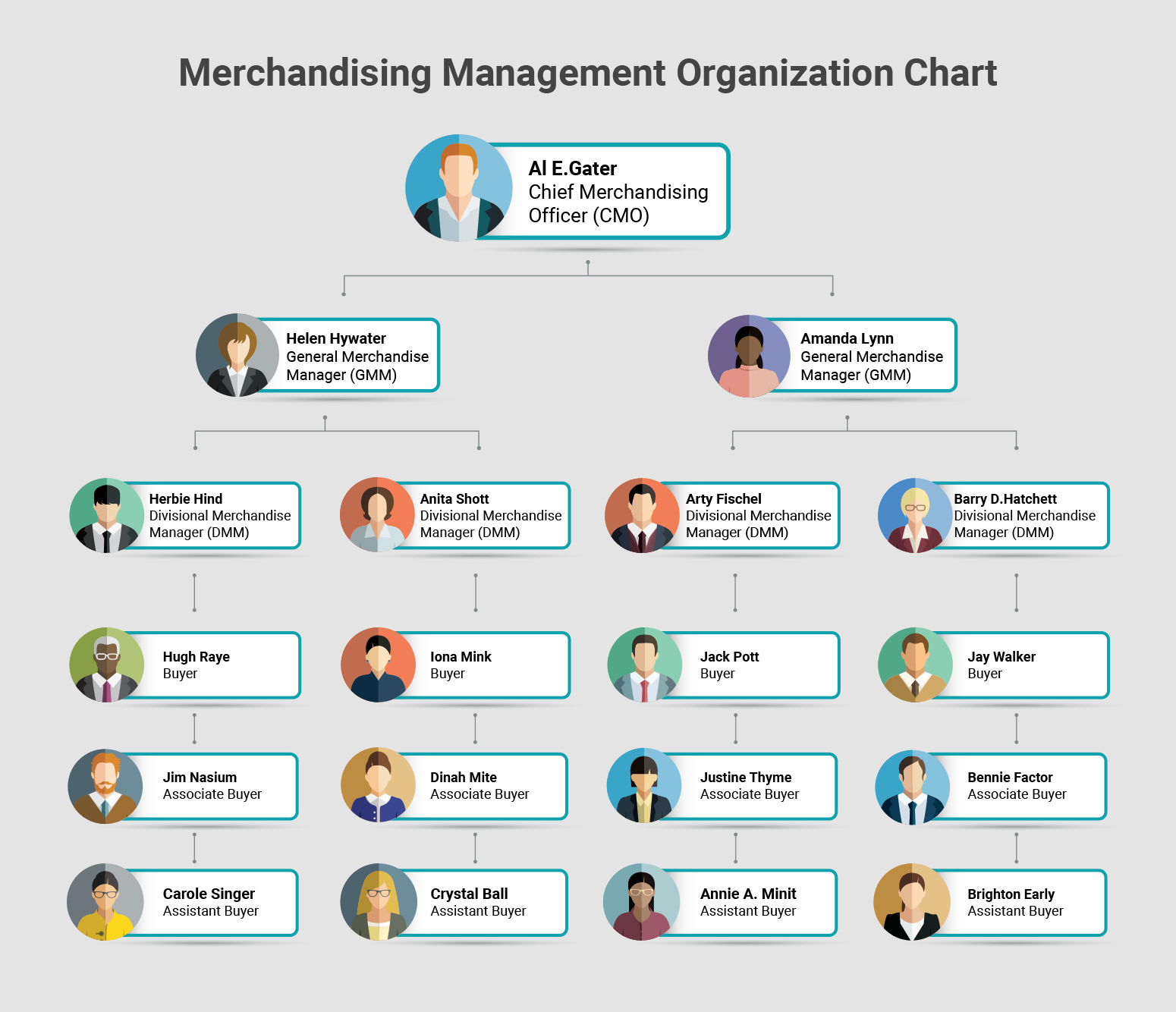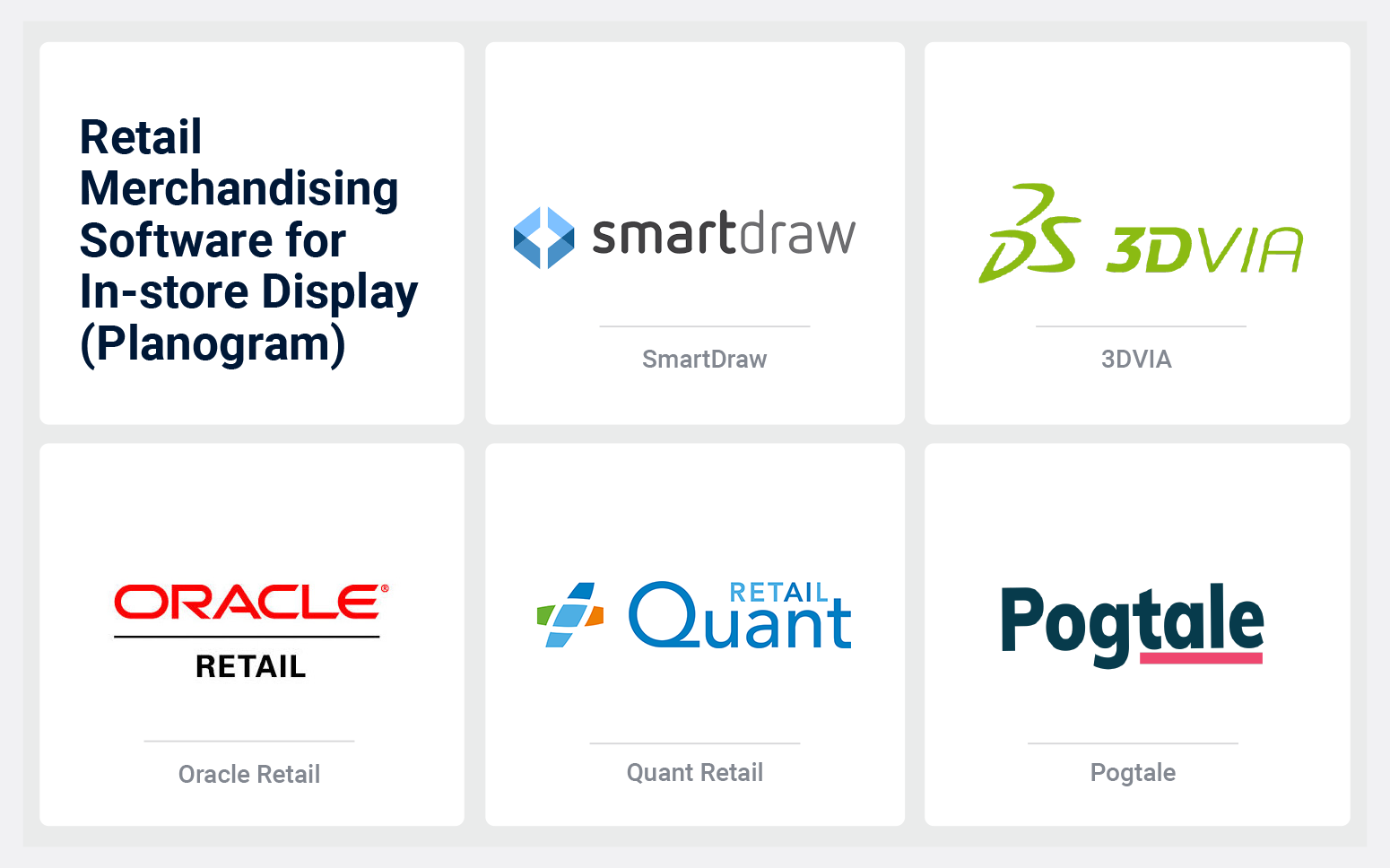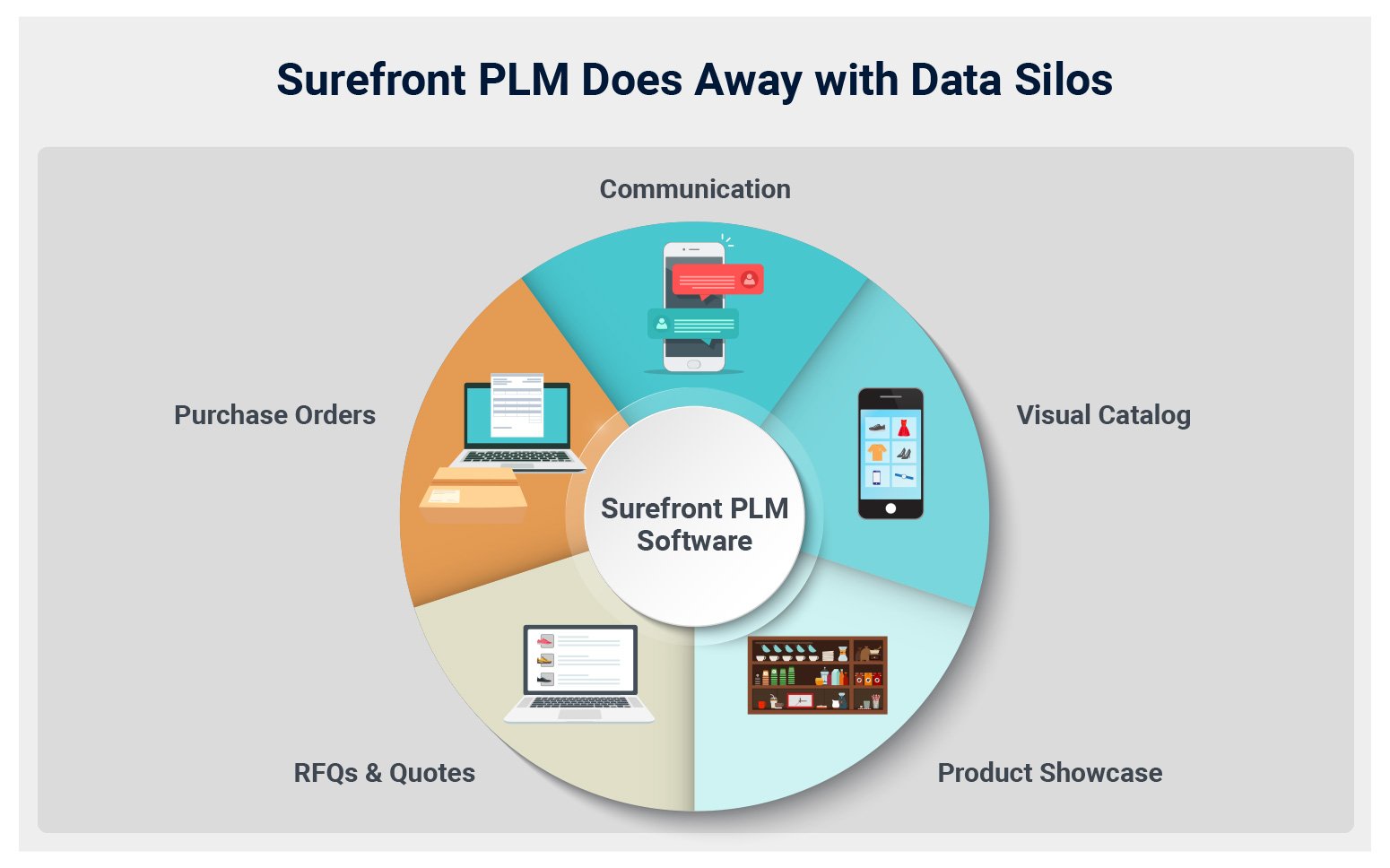Share this
Merchandising Software 101
by Surefront on Apr 22, 2021 1:49:55 PM
Home > Blog > Part 1: Merchandising Software 101
Table of Contents
- A Day in the Life of a Retail Buyer
- Who’s Involved in Merchandising
- Product Customization - Differentiating From Retail Competitors
- Buyers at the World’s Largest Retailers
- A Critical Gap in Technology for Retail Buyers
- Advancements in Merchandising Management Software
- Retail Merchandising Software for In-Store Display
- Improve Your Merchandising Management with Surefront's Unified PLM Tool
Surefront is a Unified Product Collaboration Platform with PIM, CRM, and PLM solutions. It's a centralized data home where stakeholders can freely share product information and assign access permissions. Most integrations are supported in Surefront, but none are needed. Our articles often focus on one aspect of our unified PIM, PLM, and CRM platform. With Surefront, each solution seamlessly works together to achieve a guaranteed 10x ROI for every customer.
Merchandising is a critical capability for retailers, but the full definition of merchandising, and all it entails, is less than common knowledge.
Smartsheet.com defines merchandising as, “a strategy that contributes to the sale of goods by enticing customers to make a purchase (examples include promotional deals and discounting methods).” They go on to explain, “Retail merchandising attracts customers to particular goods and services in various ways. Retail merchandising includes activities and strategies such as in-store design, the selection of specific merchandise to match a target market, and the physical and digital marketing of merchandise to customers.”
.png?width=1550&name=Mercahndising-Surefront--Process%20(1).png)
Though this is the conventional definition of “retail merchandising,” there’s a whole lot more that goes on before products hit the shelves. Not often discussed is the upstream process of merchandising that considers how retailers procure products and deal with their suppliers. The merchandising management process addresses all initiatives to purchase products, manage retail inventory, distribute products, and finalize financial agreements (purchase orders) with suppliers.
This article will expand upon the idea of merchandising, shed light on the lack of software tools in the space, and provide you with in-depth insight into the world of the retail buyer and their immense responsibility to their organizations. Here’s the quick navigation guide to the essentials:
- A Day in the Life of a Retail Buyer
- Who’s Involved in Merchandising
- Product Customization - Differentiating From Retail Competitors
- Buyers at the World’s Largest Retailers
- A Critical Gap in Technology for Retail Buyers
- Advancements in Merchandising Management Software
- Retail Merchandising Software for In-Store Display (Planogram)
- Improve Your Merchandising Management with Surefront Unified Product Collaboration Platform
A Day in the Life of a Retail Buyer
Retailer buyers, often referred to as Category Managers, are the purchasing professionals within a retail organization, from the likes of Target to Nordstrom to smaller mom-and-pop outfits, who source products from brands and suppliers and choose which products to bring in for resale. Generally, buyers will have certain departments or categories they focus on specifically.
Retail buyers have the responsibility of spending an organization’s procurement budget, which can reach the billions for the largest retailers, ahead of their target in-store dates. As they aim to stay up-to-date and ahead of the seasons, buyers have to procure products months (sometimes a year) ahead of time to ensure that they hit the shelves within the appropriate time frame. With seasons that go well beyond the scope of the usual four seasons we’re used to, buyers have the constant duty to forecast the latest trends and essential items for extremely specific target dates.
According to the Wall Street Journal, “Most shoppers see the seasons change four times a year. Retailers see 13 to 20 and all those seasons are designed to get shoppers into their stores.” This adds layers of complexity as well as urgency to a buyer’s duties. Without a crystal ball to tell them what products will perform well in their stores, buyers have to be well-equipped with market data, stay up-to-date with trends, be conscious of historical sell-through/competitive pricing, and have a keen eye for novel opportunities in their retail vertical.

Here’s what a retail buyer’s responsibilities look like on a daily basis:
- Coordinating with merchandise managers to plan, select, and purchase products for resale within the retail organization.
- Keeping abreast of market trends and studies along with analyzing sales data to help forecast product performance.
- Comp shopping to review competitor trends and pricing.
- Assessing key customer insights relative to the category, input into the assortment process.
- Managing suppliers and reviewing product offerings.
- Creating Requests for Quotes (RFQs) to suppliers for products that consider costs, quantities, sell-through, and other key logistics.
- Meeting with suppliers to discuss product customization to drive variation and unique product assortment.
- Negotiating prices, quantity, and purchasing terms with suppliers.
- Getting approval from senior management ahead of purchasing and launching new products.
- Finalizing purchase orders for selected products ahead of target seasons.
Who’s Involved in Merchandising
There’s a number of personnel and positions involved in the merchandising process for a retailer. It takes a team of experienced individuals to create a budget, execute all sourcing initiatives, and bring life to the shelves of brick-and-mortar stores with seasonally appropriate products.
Merchandising and sourcing teams share a common goal to bring in the right products, at the right prices, at the right time. All merchandising management activities keep these values at their core as they set budgets and engage with brands and manufacturers in their supply chain.
Here’s who executes important functions in the merchandising management process:
- Chief Merchandising Officer (CMO) - The CMO oversees operations of the entire merchandising department. They are responsible for overseeing the entire organization’s buying and selling with the duty to assess sell-through and other relevant data to create forward-thinking strategic plans for the merchandising department.
- General Merchandising Managers (GMM) - GMMs oversee all categories and assess them in comparison to each other. They look for gaps and overlaps within categories and assortments to avoid redundancy across these strategic business units. They take an essential role in leading DMMs, Category Managers, and the rest of the buying team to help establish and manage the budget.
- Divisional Merchandise Managers (DMM) - DMMs oversee the direction and strategy of the merchandising team. They lead the buying team by creating strategic initiatives for execution with the category managers and buyers. They also oversee visual merchandising, marketing, planning, allocation, and store operations for all matters within their division of products.
- Retail Buyers/Category Managers - Buyers are responsible for assessing products from suppliers to settle a purchasing agreement. They spend a retail organization’s open-to-buy budget ahead of time as they forecast the products the organization needs for retail seasons. These products are brought in for resale within the retail organization’s brick-and-mortar locations, e-commerce channels, and omnichannel locations. Because they oversee sourcing and strategic business for an entire category, rather than dealing with individual brands or products, buyers are often referred to as category managers within their organization. Learn more about category management here.
- Associate/Assistant Buyer - Associate buyers (also known as assistant buyers) support the buyers and all buying initiatives. They help analyze and present sell-through and profitability data to senior management. They engage in developing, acquiring, expanding merchandise/categories and writing purchase orders.
- Product Development Team - The product development team is made up of design and development individuals who are responsible for product design. They work with the in-house buying team along with external supplier partners to make design adjustments ahead of the final purchase order. When adjustments go beyond functionality and touch color stories and aesthetics, product development is heavily involved. If you want to learn more about what product development does and what tools they use, check out our article on integrated PLM tools.

Product Customization - Differentiating From Retail Competitors
Buyers and merchandising teams not only have to keep their eyes on future products, but they also have to be mindful of what their competitors are purchasing. In most situations, offering the same cookie cutter products as direct competitors is a recipe for failure. That strategy is mostly inadequate in that pricing becomes the only competitive factor. Without direct transparency into competitors’ pricing structures, it’s a dangerous gamble to compete on price tag alone.
To drive differentiation from their retail competitors, buyers often engage in product development with their suppliers. This generally entails functional design tweaks and changes to bring in a product that will stand out and create a more unique assortment across their store shelves . With data, trends, and customer personas in mind, buyers make informed decisions in their product development requests to suppliers. This process of driving innovation and variation across new product lines is critical to stay competitive in the retail landscape.
If further changes to design elements are needed to fit seasonal color stories or other aesthetic alterations, a buyer’s product development team will get involved to communicate these edits to the suppliers. This all occurs prior to settling a purchasing order.
In many cases, this iterative process of product customization with suppliers can help boost the retailer’s unique assortment and lead to new product lines. This can result in entirely new private label lines which are unique to the retailer and provide new avenues for marketability and sell-through.
Buyers at the World’s Largest Retailers
Buyers at the world’s largest big box retailers, like Walmart, have an immense duty on their hands. They tend to be in charge of a single category of goods and their team writes multi-million dollar purchase orders on a weekly basis. In a year, they can spend billions of dollars in procurement. The stakes are high for these buyers, and they represent a small population of people on the planet who spend in the billions. Buyers are not only responsible for negotiating purchase orders, they also manage the overall category revenue and margins and are accountable for their entire category’s sales.
A retailer of this magnitude has massive demand in a wide variety of departments. From clothing to electronics to home goods and more, their array of categories is far too broad for their buyers to handle more than one type of goods. Despite having one category of focus, Walmart’s retail buyers still communicate with hundreds of suppliers just to stock their single department.
Walmart buyers have a responsibility to procure products in volumes that provide them the best chance for settling lower per-unit prices. This is driven by the general big-box retailer ethos of driving down costs through the supply chain. Buyers at this level have to assess a multitude of products from a wide range of brands within their category, communicate and negotiate with those suppliers, and create purchase orders that are responsible for outfitting the shelves in some of the world’s largest stores. This is no easy feat and necessitates organized data with clear communication.
Though Walmart is one of the world’s largest retailers, their buying team is only made of roughly 1,000 categories. With 4,743 Walmart stores in the United States alone, each carrying 120,000 products, buyers have a monumental duty on their hands to forecast the needs of shoppers and bring in products that best serve their needs. With that scale of business in mind, Walmart has buyers focus on a single category of items since the need to bring in new items and replenish shelves is constant. Walmart has an estimated 240 million customer visits worldwide, with each one of those shoppers being exposed to the items selected by buyers for their shopping journey.
Walmart is an atypical example when it comes to volume and scale. Other large retailers, like Target and PetSmart, see their buyers operate with an open-to-buy budget ranging from the tens of millions to the hundreds of millions in a given year.
Buying and category management has gone through substantial evolution in the digital age. It is imperative for buyers to think about assortments online and in-store and how this comes together for the customer to easily navigate the assortment with extensive additional choices online.
Buyers at the world’s largest retailers hold some of the most important roles in the economy. Their decisions can either pave the way for growth and success for the organization or lead to significant revenue loss. Fostering a healthy supply chain is also part of the picture for buyers and the merchandising team as they engage with various suppliers and 3rd-party vendors. Check out our article on improving your supply chain through Supplier Management to learn more.
A Critical Gap in Technology for Retail Buyers
With such a massive set of responsibilities for retail buyers, you may be wondering what software tools exist that cater to their needs. The logic follows that such an important set of individuals, with such a direct footprint on the economy, would have a range of software tools that help them with their day-to-day business functions.
In spite of this, there are few tools that are truly tailored to the needs of the retail buyer. Whether we are talking about the multi-billion dollar enterprise level buyers or buyers at smaller retailers, they are left to rely on the lowest common denominators to engage with their suppliers.
This engagement comes in the form of lengthy email chains, spreadsheets, and PDF attachments. With these decades-old tools, retail buyers are subject to the chaos of data entry and information living in siloed locations. Even for the most organized individuals, this makes for a significant time sink in data re-entry and falls short of the empirical data transparency that a retail organization should have access to.
Collaboration software currently helps teams within the same organization. Where there is a massive gap for buyers is in the ability to engage with suppliers in an environment that has object-oriented communications. Until recent software advancements (more on this below), sharing product data and communicating about that information with external parties was only done via email with attachments. This leaves a lot to be desired in the way of accuracy and clarity. It also leaves no feasible way for the buyer to organize their siloed communications and data other than tedious data re-entry in spreadsheets that are still kept in disparate locations.
.png?width=1550&name=Mercahndising-Surefront-Chaos%20(1).png)
Here’s a shortlist of what retail buyers are missing when relying on email and attachments to engage their suppliers:
- Centralized data storage (with shareability).
- Object-oriented communications and historical data.
- Visual correlation between product data and corresponding communication.
- Ability to track steps and activities across team members for accountability.
- Software that facilitates external communication with 3rd-party vendors.
Advancements in Merchandising Management Software
To have a comprehensive handle on all merchandising management initiatives, retail buyers need a single source of truth for all product information. Beyond that, they need the means to communicate with their suppliers that includes product data and financial information integrated in a single platform. That’s where Surefront comes in to deliver on an end-to-end checklist of what retailers and their suppliers need.
Here’s a rundown of the tools within the Surefront platform that can help retail buyers and all who are involved in the B2B merchandising management process:
- Catalog: This serves as the central repository for all product data and relevant financial information products. It’s the easiest way to have a visual representation of the product along with all historical data that is accessible in a single place. Retailers can use this to create assortments and plan categories for their stores.
- Showcase: Buyers can view a supplier’s showcase to easily assess products with a custom selection of the brand’s newest offerings. This is one of the easiest ways to send portions of a catalog that are tailored to a buyer’s needs. As retailers adopt Surefront and onboard their suppliers, this becomes the fastest way to highlight and invite buyers to product selections. This cuts down time and effort for the buyer as they have a more tailored selection of products to review.
- Programs and Assortments: Buyers can use Surefront to manage programs and optimize assortments within the platform. This improves overall visibility for the entire merchandising team and helps organizations increase sell-through rates with better-optimized assortments.
- Quotes and Negotiations: Buyers can create Requests for Quotes (RFQs) on products directly in the platform. They can also compare historical data of past quotes to ensure that they are operating with all relevant precedents in mind. They can also create purchase orders within the platform for a cleaner negotiation path to an agreement.
- Chat: The built-in chat function is a proprietary tool that allows teammates to communicate with internal and external stakeholders with object-oriented data. That means buyers on the retail side can engage directly with their suppliers for a more direct avenue of negotiation. Each product in the platform has its own chat with history and notes attached for improved clarity.
- Order: Buyers can instantly turn quotes into purchase orders and finalize those orders in Surefront. They can easily share and export order information while keeping all relevant stakeholders up-to-date.
- Workflow: The workflow feature in the platform is an easy-to-follow chart that displays all deadlines and deliverables across stakeholders in product development and merchandising. This improves productivity with a trackable set of expectations for a higher degree of accountability. This is another key factor in improving product quality and decreasing time to market.
.png?width=1550&name=Mercahndising-Surefront---slide-11v2%20(1).png)
Surefront is a buyer’s best friend. The transparency of data along with the level of communication (both internally and externally) that they gain access to in the platform is unparalleled. Buyers can reduce their margin for error with more object-oriented historical data in the software platform. Beyond that, the elimination of data re-entry and access to workflow accountability has retail organizations see a 20% increase in productivity on average.
Retail Merchandising Software for In-Store Display (Planogram)

While Surefront is one of the few software solutions in the retail market that empowers buyers and suppliers alike, there are many software solutions that help retailers plan how items appear to customers once they are ready to hit store shelves. Planogram software is a visual merchandising tool that helps merchandising teams physically map out where products will be placed on shelves. The following is a comprehensive list of the top 5 planogram software tools used by retailers around the world.
SmartDraw - provides enterprise-grade diagramming that’s both easy and powerful. They provide thousands of design templates for all types of diagramming. Merchandising teams find this software to be particularly useful for space planning and creating planograms.
3DVIA - provides enterprises and consumers with smart 3D space planning solutions that enable new easy to engage, consider, and make the best choice for their businesses.
Quant Retail - Quant is a cloud solution for the management of retail space, product categories, planograms, shelf labels, automatic replenishment and store photo documentation. It is an all-in-one software solution for retail space management.
Improve Your Merchandising Management with Surefront's Unified PLM Tool
Data dies in silos, plain and simple. When merchandising teams are left to lean on emails with attachments and separate channel-based communications tools, transparency and context go down the drain.

Surefront Unified Product Collaboration Platform fights against this by unifying PLM and the two other aforementioned tools into a clean, streamlined format. Our platform is accessible for your merchandising and product development teams, while being secure enough to keep your sensitive data safe. If you’re familiar with Product Lifecycle Management software, you need to unlearn most of what you know about the average platform. Surefront is elevating PLM tools beyond a solution that simply helps product development teams, into one that also facilitates your sales and data management processes... in a fraction of the time.
We understand that half the battle is creating the right product for your buyers and customers. Unified product collaboration tools solve this by creating an ecosystem for development professionals to collaborate on tech packs and bill of materials (BOM) and more over a series of cycles that trim waste, optimize the development process, and refine your supply chain.
The other half of that battle is providing the right tools for merchandising teams to engage with 3rd party collaborators like suppliers and manufacturers. So, whether you’re in sales on the supplier side, or in merchandising and procurement on the retailer side, Surefront Unified Product Collaboration Platform provides you the tools to work with your external partners to view visual catalogs, product showcases, list products, request quotes, and review purchase orders. This is the only cloud-based ecosystem that takes products from concept all the way to market, with all data and communications stored along the way.
Empower your retail buyers and suppliers to communicate more effectively, manage data more responsibly, and bring products to market more efficiently. Surefront Unified Product Collaboration Platform is filling undeniable gaps for retailers, while strengthening the supply chain with value-added tools for all key stakeholders.
Share this
- PLM Software (36)
- PIM Software (29)
- Apparel & Fashion (20)
- Trending Topics (20)
- Merchandising (16)
- CRM Software (13)
- PLM Implementation (11)
- Catalog Management (6)
- Tech Packs (6)
- PLM RFP (5)
- Success Stories (5)
- Sustainability (5)
- Data Import (4)
- Line Sheet (4)
- Luxury Goods & Jewelry (4)
- Product Development (4)
- Retail (4)
- Supply Chain (4)
- Category Management (3)
- Home Furnishings (3)
- Wholesale (3)
- Consumer Packaged Goods (CPG) (2)
- Cosmetics (2)
- Data Export (2)
- Health & Beauty (2)
- RFQ & Quote Management (2)
- Consumer Electronics (1)
- Import & Export (1)
- Industry Events (1)
- Inventory Management (1)
- Pet Stores (1)
- Purchase Orders (1)
- Report Builder (1)
- Textiles & Raw Materials (1)
- Unified Solution (1)
- Vendor Management (1)
- Visual First (1)
- White Paper or Case Study (1)
- workflow (1)
- October 2025 (3)
- September 2025 (3)
- August 2025 (4)
- April 2025 (4)
- March 2025 (3)
- January 2025 (8)
- December 2024 (5)
- November 2024 (3)
- October 2024 (5)
- September 2024 (6)
- August 2024 (2)
- July 2024 (1)
- June 2024 (3)
- May 2024 (4)
- April 2024 (5)
- March 2024 (3)
- February 2024 (2)
- December 2023 (4)
- September 2023 (2)
- August 2023 (5)
- July 2023 (3)
- June 2023 (2)
- May 2023 (2)
- April 2023 (4)
- March 2023 (5)
- February 2023 (3)
- January 2023 (5)
- December 2022 (4)
- November 2022 (3)
- October 2022 (4)
- September 2022 (5)
- August 2022 (4)
- July 2022 (2)
- May 2022 (1)
- February 2022 (1)
- January 2022 (1)
- September 2021 (1)
- May 2021 (1)
- April 2021 (1)
- February 2021 (1)
- May 2020 (1)